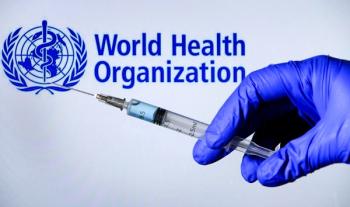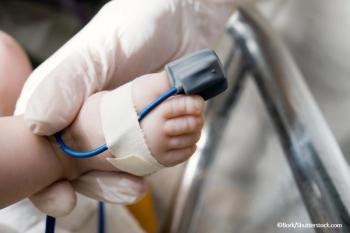
What Do These Images Reveal?
A 39-year-old African American man complains of mild dyspnea that has worsened steadily over the past 2 weeks and that is unrelated to activities or unusual exposures. He denies trauma, fever, and chest pain. His medical history is unremarkable.
Mild dyspnea in an African American man
A 39-year-old African American man complains of mild dyspnea that has worsened steadily over the past 2 weeks and that is unrelated to activities or unusual exposures. He denies trauma, fever, and chest pain. His medical history is unremarkable.
This thin man is in no acute distress. Temperature is 37.2ºC (99.1ºF); heart rate, 87 beats per minute with normal rhythm; respiration rate, 18 breaths per minute; and blood pressure, 135/87 mm Hg. Head and neck are normal, with no adenopathy evident. Breath sounds are minimal and diffusely decreased. Abdomen is soft and nontender, with normal bowel sounds. Extremities are normal.
You order chest radiographs to investigate further the cause of the patient's dyspnea. What do these films reveal, and what additional tests will you order to help nail down the diagnosis?
(Answer begins on page 912.)
Mild dyspnea in an African American man: Frontal (A) and lateral (B) upright radiographs of the chest reveal bulky hilar adenopathy with small nodules identified diffusely within the lungs. The differential diagnosis of bulky hilar adenopathy with diffuse, small nodules includes lung cancer, metastatic disease, lymphoma, infections (particularly fungal infections and tuberculosis), and sarcoidosis.
A CT scan of the chest is ordered to further characterize the findings and to plan for any intervention or biopsy that may be needed. Both mediastinal and lung windows are included in the study. Images in mediastinal windows at the top of the aortic arch (C) and at the level of the aorticopulmonary window (D) confirm the presence of mediastinal adenopathy (arrows). Images in lung windows in the subcarinal region (E) and at the lung bases (F) reveal diffuse, small nodules.
Based on the CT and plain film findings, the differential diagnosis includes lymphoma, primary lung carcinoma, and metastatic disease. However, the patient's age makes malignancy unlikely. In addition, any malignancy associated with radiographic findings this troublesome would normally produce more severe pulmonary symptoms as well as some systemic symptoms.
Infectious causes need to be considered--most notably, tuberculosis and fungal disease. However, in both these infections, an airspace is present and the patient typically has a history of cough and fever. Also, the CT images do not have a "tree-in-bud" appearance or reveal calcification of nodes, both of which are typical findings in granulomatous infectious disease. Nonetheless, immunocompromised states can give rise to infection with unusual pathogens that could produce atypical findings, and the possibility of such an infection should be kept in mind. Although there is no evidence that this man is immunocompromised, suspicion is always prudent when such gross findings are identified in a younger patient.
Because of the patient's age and race, sarcoidosis is a strong possibility. The mild clinical symptoms, together with radiographic and CT findings of aggressive disease, are typical of this entity. However, parenchymal lung involvement in sarcoidosis is usually more alveolar--at all stages of the disease--than that seen here.
The patient's angiotensin-converting enzyme level is high. An ophthalmologic consultation reveals uveitis. Bronchoscopic biopsy reveals noncaseating granulomas that are consistent with sarcoidosis. The final diagnosis is nodular sarcoidosis.
Characteristics of nodular sarcoidosis. This is an uncommon presentation of a common disease. Patients with the condition are typically young adults aged between 20 and 40 years. Those most commonly affected are African American women around the age of 25 years.
Nodules in the lungs usually range in size from 1 to 7 cm. Histologically, they represent the coalescence of smaller sarcoidal granulomas. These nodules can easily be mistaken for metastatic disease, both because of their multiplicity and the commonly associated lymphadenopathy. In addition, nodules are often evident in other organs, such as the liver and the spleen.
Lung nodules tend to follow the typical distribution of sarcoidosis: along the lymphatics of the peribronchovascular interstitium to the central portions of the lobes of the lungs and, to a lesser degree, to the subpleural interstitium. In more classic forms of the disease, the involvement of the lung parenchyma is reticulonodular but has the same distribution.
The 5 stages of sarcoidosis. Chest findings in sarcoidosis often follow a predictable course, which has been broken down into 5 stages:
•Stage 0: normal chest radiograph.
•Stage 1: adenopathy of the mediastinum, most commonly bilateral hilar and right paratracheal.
•Stage 2: mediastinal/hilar adenopathy with parenchymal lung disease.
•Stage 3: parenchymal lung disease without adenopathy.
•Stage 4: parenchymal lung fibrosis/end-stage lung disease.
Stage 0 disease is seen on presentation in 5% to 10% of patients with sarcoidosis. CT may reveal unsuspected chest disease in these patients.
Stage 1 disease is seen in about half of affected patients. Hilar ade- nopathy is usually bilateral and symmetric, and it is frequently associated with right paratracheal nodal enlargement. CT often shows additional lymphadenopathy at other sites, such as the anterior mediastinal, subcarinal, posterior mediastinal, internal mammary lymph node chain, or axillary regions. The enlarged nodes are discrete and maintain their shape. Although the lungs appear clear on chest radiographs at this stage, interstitial granulomas are found on transbronchial biopsy in the majority of patients. Half of patients with stage 1 disease are asymptomatic, and in 60% to 80%, the condition resolves within 2 years. However, in up to 25% of patients, the disease will progress from stage 1 to stage 2.
Stage 2 disease is seen in 25% to 35% of patients. Pulmonary disease usually appears as the intrathoracic adenopathy is regressing. It is frequently bilateral and diffuse, with upper lobe predominance. Several patterns, including reticulonodular, acinar, large nodules, and mixed-type have been described. In the reticulonodular pattern, the nodules are peribronchovascular in distribution, vary in size from 1 mm to 1 cm, and often have irregular margins. In the acinar pattern, the pulmonary opacities are characterized by fluffy margins, air bronchograms, and coalescence. The acinar pattern has the appearance of airspace disease but is created instead by extensive interstitial disease that compresses the adjacent airspaces. The pattern of large nodules or masses, in which the average lesion size is larger than 1 cm, is seen in only 2% of patients. This is the pattern in our patient. Spontaneous remission of pulmonary disease occurs in only 50% of patients with stage 2 disease.
Stage 3 disease is seen in approximately 15% of patients with sarcoidosis. Chest radiography shows only pulmonary parenchymal changes (as seen in stage 2), without adenopathy. Patients with stage 3 disease show an increased tendency toward fibrosis; spontaneous remission occurs in only 30%.
Stage 4 disease, or end-stage fibrosis, is seen in 20% of patients. Typical changes include reticular opacities with architectural distortion, retraction of hila or fissures superiorly, cysts or bullae formation, bronchiectasis, honeycombing, and conglomerate masses. Pulmonary artery hypertension and cor pulmonale may develop in patients with stage 4 disease.
Other manifestations of sarcoidosis seen in more advanced disease (stages 2 through 4) include atelectasis (secondary to endobronchial disease or nodal compression), cavitation (which can suggest superimposed tuberculosis or fungal infec- tion), pleural effusion, pneumothorax, calcification in mediastinal or hilar lymph nodes, and bony changes.
Role of CT in diagnosis and management of sarcoidosis. CT and high-resolution CT are superior to plain radiography for identification of the disease pattern and extent. These modalities allow earlier recognition of parenchymal lung changes, including fibrosis. CT, and particularly high-resolution CT, may reveal parenchymal disease in patients with normal chest radiographs or in patients whose chest films show only hilar adenopathy.
Several attempts have been made to correlate the extent of disease seen on CT with clinical and pulmonary function tests. It has been shown that patients with predominantly nodular opacities exhibit less functional impairment than do those with predominantly reticular opacities. CT can also be used to evaluate response to therapy.
Outcome of this case. The patient refused therapy and was lost to follow-up.
Newsletter
Enhance your clinical practice with the Patient Care newsletter, offering the latest evidence-based guidelines, diagnostic insights, and treatment strategies for primary care physicians.



















































































































































































































































































